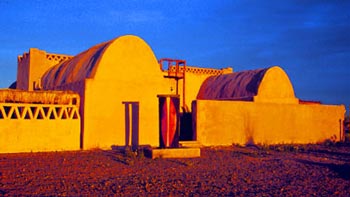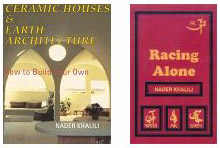According to the discussion group at www.designcommunity.com, “Frank Lloyd Wright did design a berm house for a small commune who were building their own homes outside of Detroit in 1940 or 1941. Construction was begun on one house when the war intervened. The other oddity about this design was the use of rammed earth for the walls. The unfinished house was abandoned when the residents were drafted.”
The Adobe Alliance

The Adobe Alliance, led by Simone Swan, is an organization whose goals are to to build low-cost energy efficient housing that is climatically and environmentally compatible and to fill widespread needs for sustainable, salubrious housing while enhancing the unique landscape of the Big Bend region of West Texas and other desert environments.
Earthquake Proof Houses Hard to Sell
Iran-born architect Nader Khalili has a technique for building earthquake-proof houses, but he is struggling to sell it to governments even though he teaches it for free and it could save countless lives.
Books By Paul Graham McHenry

The trilogy of books by New Mexico author, teacher, and builder, Paul Graham McHenry, are a staple to the library of anyone interested in building or designing with earth.
Adobe and Rammed Earth Buildings: Design and Construction
Superadobe Iran
Iranian-born architect, Nader Khalili, now working in California’s seismic zone urged his fellow Iranians to try his “superadobe” building technique, using sandbags and barbed wire, in rebuilding the 2,000 year old quake-flattened city of Bam.
Cornerstones Community Partnerships
Cornerstones Community Partnerships, a Santa Fe-based non-profit organization, works primarily with rural Hispanic villages and Indian Pueblos in New Mexico and the southwest to restore historic structures. It encourages traditional building techniques and works to retain cultural heritage and foster civic pride through historic preservation. For the past seventeen years, Cornerstones has assisted over 300 rural Hispanic and Native American communities throughout New Mexico, Colorado, Arizona, and Texas in the restoration of their historic and cultural structures as a means for the preservation of the rich cultural heritage unique to this region. Over 50 major restoration projects, led by the community, have been successfully completed.
Earth Room
The New York Earth Room, 1977, is the third Earth Room sculpture executed by artist Walter de Maria, the first being in Munich, Germany in 1968. The second was installed at the Hessisches Landesmuseum in Darmstadt, Germany in 1974. The first two works no longer exist. The New York Earth Room has been on long-term view to the public since 1980. This work was commissioned and is maintained by Dia Art Foundation and is an interior earth sculpture comprised of 250 cubic yards of earth (197 cubic meters) over 3,600 square feet of floor space (335 square meters) with a 22 inch depth of material (56 centimeters). The total weight of the sculpture is 280,000 lbs. (127,300 kilos).
Nader Khalili

Iranian born Nader Khalili, California architect/author is the world renowned Earth Architecture teacher and innovator, and author. He has been a licensed architect in the State of California since 1970, and has practiced both in the U.S. and abroad. Click here to visit Khalili’s website: Cal-Earth, The California Institute for Earth Art and Architecture.
His books, Ceramic Houses and Earth Architecture: How to Build Your Own and Racing Alone document his life of searching for a method to fire mud houses and turn them to stone by firing and glazing an entire building after it is constructed from clay-earth on site.
Los Angeles Greater Metropolitan Area Adobes
Among the Things to do in Los Angeles are visit the 103 adobe sites where adobe buildings once stood, or visit the 76 extant historic adobe structures listed by region below:
Los Angles County (12)
Orange County (10)
San Diego (17)
Santa Barbara (20)
Ventura (13)
Inland Empire (4)
Rural Studio

The book, Rural Studio: Samuel Mockbee and an Architecture of Decency documents several rammed earth structures designed and built by Auburn School of Architecture students in Hale County, Alabama.
